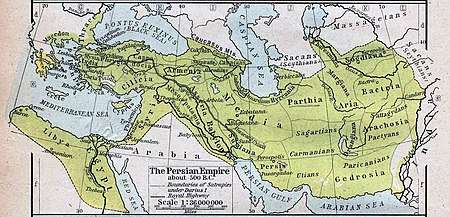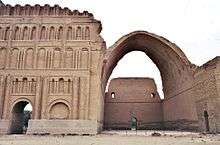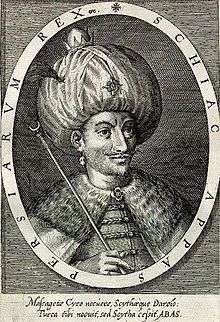Persian Empire
The Persian Empire or Imperial Iran (Persian: شاهنشاهی ایران, translit. Šâhanšâhiye Irân) is any one of the many imperial dynasties centred in Iran (Persia) from the 6th century BCE, the Achaemenid Empire, to the 20th century CE, the Pahlavi dynasty.


History
Achaemenids
The first dynasty of the Persian Empire was created by the Achaemenids, established by Cyrus the Great in 550 BC with the conquest of the Median, Lydian and Babylonian empires.[1][2] It covered much of the then known Ancient world.[3] Persepolis, the most famous historical site related to Persian Empire in the Achaemenid era, has been a UNESCO World Heritage Site since 1979.[4]
Sasanians
From 247 BC to 224 AD, Persia was ruled by the Parthian Empire, which supplanted the Hellenistic Seleucid Empire, and then by the Sassanian Empire, which ruled up until the mid-7th century.[5] The Persian Empire in the Sasanian era was interrupted by the Arab conquest of Persia in 651 AD, establishing the even larger Islamic caliphate, and later by the Mongol invasion. The main religion of ancient Persia was the native Zoroastrianism, but after the seventh century, it was slowly replaced by Islam.[6]
Safavids

The Safavid Empire of 1501 to 1736 was the greatest Iranian Empire established after the 7th-century Muslim conquest of Persia. From their base in Ardabil, the Safavid Persians established control over parts of Greater Persia/Iran and reasserted the Persian identity of the region, becoming the first native Persian dynasty since the Sasanian Empire to establish a unified Persian state.[7]
Literature, art and architecture flourished in the Safavid era, which is often cited as the "rebirth of the Persian Empire". The Safavids also declared Shia Islam the official religion in their empire - as opposed to the Sunni Islam predominant in the neighbouring Ottoman Empire. The Safavid Empire became the first Muslim Iranian state to rival in importance the Ottomans in Turkey (14th to 20th centuries) and the Mameluks in Egypt (1250-1517).[8]
Afshars
The Afsharid dynasty was an Iranian dynasty that originated in Khorasan from the Afshar tribe. The dynasty was founded by Nader Shah. Nader rose to power during a period of chaos in Iran after a rebellion by the Hotaki Pashtuns had overthrown the weak Sultan Husayn, while the arch-enemy of the Safavids, the Ottomans, as well as the Russians had seized Iranian territory for themselves. Nader reunited the Iranian realm and removed the invaders. He became so powerful that he decided to depose the last members of the Safavid dynasty, which had ruled Iran for over 200 years, and become Shah himself in 1736. The Afsharids ruled Iran from 1736 to 1796.
Zands
The Zand dynasty was an Iranian dynasty of Lak a branch of Lurs[9] origin founded by Karim Khan Zand that initially ruled southern and central Iran in the 18th century. It later quickly came to expand to include much of the rest of contemporary Iran, as well as Azerbaijan, Bahrain,[10] and parts of Iraq and Armenia.
Qajars
In 1796, after the fall of the Zand and Afsharid dynasties, Agha Mohammad Khan of Qajar dynasty was the sole ruler of Iran. But soon after, in 1797, he was assassinated by his servants. Since he had no children, the shah was succeeded by his nephew, Fath-Ali Shah.[11] The reign of Fath-Ali Shah saw huge and irrecoverable territorial loss for the Persian Empire after wars against the Russians in 1804–13 and 1826–28.[12] Fath-Ali died in 1834 and was succeeded by his grandson, Mohammad Shah.[13]
During his short reign, Mohammad Shah tried to modernize the Iranian army and recapture Herat. However, his attempts were unsuccessful. He died at the age of 40 in Mohammadieh Palace in 1848. After the death of Mohammad Shah, his son, Naser al-Din Shah, ascended to the Sun Throne. He ruled for 50 years, and became the third longest reigning monarch in Iranian history after Shapur II and Tahmasp I. Many events took place during his long reign, including wars with the British Empire, the rebellion of Babis, the assassination of Amir Kabir, and the Tobacco Protest.
After the assassination of Naser al-Din Shah, Mozaffar ad-Din Shah ascened to the throne. The first Iranian revolution, the Constitutional Revolution, took place during his reign.[14] Mozaffar ad-Din Shah was the last shah who died in Iran. Mohammad Ali Shah Qajar succeeded his father in 1907. He dissolved the parliament and declared the Constitution abolished[15] and bombarded the Majlis.[16] However, he abdicated after the Triumph of Tehran by pro-Constitution forces and re-establishment of the constitution.[17]
Following the abdication of the shah in 1909, the Majlis placed his 6-years-old son, Ahmad Shah on the Iranian throne.[18] World War I took place during his reign and Iran declared neutrality. However, it didn't stop the British forces and they occupied many parts of Iran, which caused the Great famine of 1917–1919 and death of 2 million Iranians.[19][20][21]
With the 1921 Persian coup d'état, Reza Pahlavi took control of the country.[22] Ahmad Shah left Iran for health reasons In 1923 and with the official end of the Qajar dynasty in 1925 and the rise of the Pahlavi dynasty, his tour became an exile. He died in 1930 in Paris.
Pahlavi dynasty
The Pahlavi dynasty was the last ruling house of the Imperial State of Iran from 1925 until 1979, when the Persian monarchy was overthrown and abolished as a result of the Iranian Revolution. The dynasty was founded by Reza Shah Pahlavi in 1925, a former brigadier-general of the Persian Cossack Brigade, whose reign lasted until 1941 when he was forced to abdicate by the Allies after the Anglo-Soviet invasion of Iran. He was succeeded by his son, Mohammad Reza Pahlavi, the last Shah of Iran.
List of dynasties
- Achaemenid Empire (550–330 BC)
- Sasanian Empire (224–651 AD)
- Safavid dynasty (1501–1736 AD)
- Afsharid dynasty (1736–1796 AD)
- Zand dynasty (1751–1794 AD)
- Qajar dynasty (1785–1925 AD)
- Pahlavi dynasty (1925–1979 AD)
.svg.png)
Extent of the first Persian Empire, the Achaemenid Empire .svg.png)
Extent of the Sasanian Empire in 621 .svg.png)
The maximum extent of the Safavid Empire under Shah Abbas I .svg.png)
Extent of the Afsharid Empire under Nader Shah, around 1740. The borders only shrank since Nader's murder.
See also
References
Citations
- Herodotus (2015) [2014]. "Halicarnassus". The Histories. Penguin Classics Deluxe (Reprint ed.). London: Penguin Classics. pp. (page needed). ISBN 978-0143107545.
- Briant 2002, p. 15.
- Kleber, Kristin (2015-11-12). "Taxation in the Achaemenid Empire". doi:10.1093/oxfordhb/9780199935390.013.34.
The Achaemenid (or First Persian) Empire (538–330 b.c.e.) stretched from Libya to modern-day Afghanistan and from Greece to India, covering a surface of approximately 8 million square kilometers.
Cite journal requires|journal=(help) - Centre, UNESCO World Heritage. "Persepolis". UNESCO World Heritage Centre. Retrieved 2019-06-10.
- "Sasanian Dynasty – Encyclopaedia Iranica". www.iranicaonline.org. Retrieved 2019-06-10.
Sasanian Dynasty, the last Persian lineage of rulers to achieve hegemony over much of Western Asia before Islam, ruled 224 CE–650 CE.
- "Conversion ii. Of Iranians to Islam – Encyclopaedia Iranica". www.iranicaonline.org. Retrieved 2019-06-10.
Iranians were among the very earliest converts to Islam, and their conversion in significant numbers began as soon as the Arab armies reached and overran the Persian plateau. Despite some resistance from elements of the Zoroastrian clergy and other ancient religions, the anti-Islamic policies of later conquerors like the Il-khanids, the impact of the Christian and secular West in modern times, and the attraction of new religious movements like Babism and the Bahai faith, the vast majority of Iranians became and have remained Muslims.
- Roemer, H. R. (1986). "The Safavid Period". The Cambridge History of Iran. Retrieved 2019-06-11.
Whether we think of this event as marking the beginning of modern Persian history or not, it certainly heralds a new era. The historical achievement of the Safavids was to establish a strong, enduring state in Iran after centuries of foreign rule and a lengthy period of political fragmentation.
-
Roemer, H. R. (1986). "The Safavid Period". The Cambridge History of Iran. Retrieved 2019-06-11.
Not until the Safavid era did Iran witness the rise of a state similar in importance to the Ottoman empire or the empire of the Egyptian Mamlūks.
- Muhammad Karim Khan, of the Zand clan of the Lur tribe, suc- ceeded in imposing his authority on parts of the defunct Safavid empire, David Yeroushalmi, The Jews of Iran in The Nineteenth Century: Aspects of History, Community, and Culture, Brill 2009, ISBN 978-90-04-15288-5, p. xxxix.
- "A Brief History of Bahrain".
- Cyrus Ghani (6 January 2001). Iran and the Rise of the Reza Shah: From Qajar Collapse to Pahlavi Power. I.B.Tauris. pp. 9–. ISBN 978-1-86064-629-4. Retrieved 4 November 2012.
- Dowling, Timothy C. (2014). Russia at War: From the Mongol Conquest to Afghanistan, Chechnya, and Beyond [2 volumes]. ABC-CLIO. ISBN 978-1-59884-948-6.CS1 maint: ref=harv (link), page 728
- "Index Fa-Fi". Rulers. Retrieved 26 July 2013.
- Soltan Ali Mirza Kadjar, 'Mohammad Ali Shah: The Man and the King', in: Qajar Studies. Travellers and Diplomats in the Qajar Era. Journal of the International Qajar Studies Association, volume VII, 2007.
- Donzel, Emeri “van” (1994). Islamic Desk Reference. ISBN 90-04-09738-4. pp. 285–286
- "BBC Persian". Bbc.co.uk. Retrieved 2017-05-18.
- Soltan Ali Mirza Kadjar, 'Mohammad Ali Shah: The Man and the King', in: Qajar Studies. Travellers and Diplomats in the Qajar Era. Journal of the International Qajar Studies Association, volume VII, 2007.
- History of Iran: Qajar Dynasty
- Abrahamian 2013, pp. 26–27: "A contemporary Iranian historian recently made the wild accusation that British food exactions to feed its army of occupation during World War I resulted in 10 million dead—half the population. He accuses the British government of "covering up" this "genocide" by systematically destroying annual reports. In fact, no annual reports on Iran were written from 1913 until 1922; the British expeditionary force of some 15,000 would not have required that much grain; and although as many as 2 million may have lost their lives in these years, the vast majority died not because of food exactions but from cholera and typhus epidemics, from a series of bad harvests, and, most important of all, from the worldwide 1919–20 influenza pandemic."
- Katouzian 2013, p. 1934: "Russian Revolution of 1917 brought much relief to Iran after a century of imperial interference and intimidation. But it was followed by severe famine and the Spanish flu pandemic which, combined, took a high toll of around two million, mostly of the Iranian poor."
- Rubin 2015, p. 508: "Despite Iran's official neutrality, this pattern of interference continued during World War I as Ottoman-, Russian-, British-, and German-supported local forces fought across Iran, wreaking enormous havoc on the country. With farmland, crops, livestock, and infrastructure destroyed, as many as 2 million Iranians died of famine at the war's end. Although the Russian Revolution of 1917 led to the recall of Russian troops, and thus gave hope to Iranians that the foreign yoke might be relenting, the British quickly moved to fill the vacuum in the north, and by 1918, had turned the country into an unofficial protectorate."
- Cyrus Ghani; Sīrūs Ghanī (6 January 2001). Iran and the Rise of the Reza Shah: From Qajar Collapse to Pahlavi Power. I.B.Tauris. pp. 147–. ISBN 978-1-86064-629-4.
Sources
- Briant, Pierre (2002). From Cyrus to Alexander: A History of the Persian Empire. University Park, Pennsylvania: Eisenbrauns. p. 15. ISBN 978-1575060316.CS1 maint: ref=harv (link)
- DK (2014). History of the World in 1,000 Objects. London: DK. p. 71. ISBN 978-1465422897.
External links
- Chisholm, Hugh, ed. (1911). . Encyclopædia Britannica (11th ed.). Cambridge University Press.

